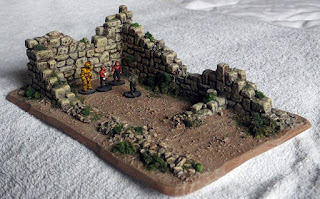I've been working on some buildings constructed from surface mount pattress boxes since around May. I've used 3 depths, 25mm, 32mm and 45mm. I've also used 2 widths, single and double socket sized. All came from Toolstation, ranging from 54p to £1.14.
All boxes were well sanded with a wet and dry foam sanding pad to give a good surface key for painting and remove any sharp edges.
 |
| Basic materials and tools. |
I've used mainly plasticard and Lego parts to enhance the buildings and add detail. Main structural elements (eg roof) use 1.5mm plasticard while thinner sheets and textured sheets (treadplate, corrugated) are used for surface detailing such as doors, panels etc. Various other wires, old toys etc will also come in useful.
 |
| Lego enhancements. |
Doors have been scratch built from thin plasticard. Most will have entry pads added from Ainsty Castings (now sold by Brigade Models) 15mm stowage basket sets. These etched brass sets come with 4 stowage baskets of varying styles on each frame, plus a couple or radar dishes, a small grille and a couple of display screens/keypads.
 |
| Scratch built doors. |
I've used some 1.5mm plasticard for walls/barricades. Small Lego curved slopes (part number 11477/17134) form the supports to either side and a section of corrugated plasticard to create a more interesting texture along the centre.
 |
| Plasticard and Lego barricades. |
The largest building is a 2 storey workshop (45mm lower storey with 32mm upper storey) with the upper floor mounted at 90 degrees to the ground floor. Windows are created from Lego windows (part number 28961) glued on sideways. The door is Evergreen/plastruct metal siding plasticard with Lego curved slope (part number 13731 razor-sawed to size) sides.
 |
| 2 storey workshop with office above. |
The flat roof has some hatches and a Lego brick electrical cabinet with plasticard doors etc. The height of the building provides a strong attachment for the Lego girder tower (part number 58827).
 |
| Flat roof area with electrical cabinets and hatches, |
Plastruct steps provide access to a plasticard treadplate platform. The overhanging office section is supported by a pair of Lego inclined stanchions (part 4476).
 |
| Note stairs to roof and supports for overhanging office. |
More Evergreen metal siding plasticard provides doors for this 45mm tall double garage / workshop, plus some sloping vents at the top of the wall.
 |
| Double garage building. |
A smaller workshop has a nice large door plus 32187 "extension for transmission driving ring" chimneys.
 |
| Small workshop. |
 |
| Small workshop side door - with access control. |
 |
| Rear of small workshop. |
Guitar strings make useful bits of cabling. Small lego tiles and scraps of thick plasticard make junction boxes.
 |
| Side of small workshop. |
 |
| Small workshop 2 with roller door and canopy. |
 |
| Rear of small workshop 2 with plant and machinery. |
 |
| Small workshop 2 with small vents. |
 |
| Communications antenna from Lego. |
Painting has started but more on that another time!




































































